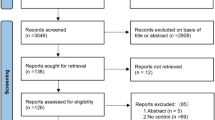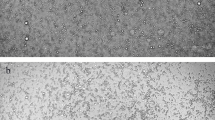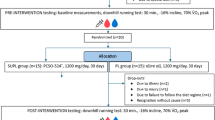Abstract
Study design:
A cross-sectional study with comparison group.
Objectives:
To examine the effect of rugby training on the blood antioxidant capacity in able-bodied and wheelchair rugby players with tetraplegia.
Setting:
Poland.
Methods:
Four groups of subjects participated in the study: sedentary able-bodied males (group SA, n=19), sedentary males with tetraplegia (group ST, n=10), able-bodied rugby players (group RA, n=22) and wheelchair rugby players with tetraplegia (group RT, n=14). The activities of superoxide dismutase (SOD), glutathione reductase (GR) and catalase (CAT) were determined in erythrocyte hemolysates, whereas glutathione peroxidase (GPX) activity was determined in whole-blood hemolysates. Concentrations of total antioxidant status (TAS) was determined in plasma.
Results:
SOD activity was significantly higher in the group SA compared with group ST and group RA. No significant differences occurred within the tetraplegic groups: RT and ST. Resting CAT and GPX activities were significantly higher in both the groups of rugby players than in the respective group of sedentary males. There were no differences in GR activity among all the studied groups. Plasma TAS concentration was higher in both the groups of able-bodied males compared with the respective groups of tetraplegics. The present study is the first to conduct an evaluation of wheelchair rugby training-induced adaptations to oxidative stress in individuals with tetraplegia.
Conclusion:
Adaptive response to training was similar in both able-bodied and wheelchair rugby players, and it was characterized by increased erythrocyte CAT and GPX activities in resting conditions improving resistance to oxidative stress.
Similar content being viewed by others
Log in or create a free account to read this content
Gain free access to this article, as well as selected content from this journal and more on nature.com
or
References
Morgulec N, Kosmol A, Vanlandewijck Y, Hübner-Woźniak E . Anaerobic performance of active and sedentary male individuals with quadriplegia. APAQ 2005; 22: 253–264.
Gabbett T, Kinf T, Jenkins D . Applied physiology of rugby league. Sports Med 2008; 38: 119–138.
Radak Z, Chung HY, Goto S . Systemic adaptation to oxidative challenge induced by regular exercise. Free Radic Biol Med 2008; 44: 153–159.
Brites FD, Evelson PA, Cristiansen MG, Nicol MF, Asilico MJ, Wikinski RW et al. Soccer players under regular training show oxidative stress but not improved plasma antioxidant status. Clin Sci 1999; 96: 381–385.
Bloomer RJ, Goldfarb AH . Anaerobic exercise and oxidative stress: a review. Can J Appl Physiol 2004; 29: 245–263.
Radak Z, Chung HY, Koltai E, Taylor AW, Goto S . Exercise, oxidative stress and hormesis. Ageing Res Rev 2008; 7: 34–42.
Finaud J, Lac G, Falaire E . Oxidative stress. Relationship with exercise and training. Sports Med 2006; 36: 327–358.
Valko M, Leibfritz D, Moncol J, Cronin MT, Mazur M, Telser J . Free radicals and antioxidants in normal physiological functions and human disease. Int J Biochem Cell Biol 2007; 39: 44–84.
Price M . Energy expenditure and metabolism during exercise in persons with spinal cord injury. Sports Med 2010; 40: 681–696.
Barfield JP, Malone LA, Arbo C, Jung AP . Exercise intensity during wheelchair rugby players. J Sports Sci 2010; 28: 389–398.
Panotopoulos G, Ruiz JC, Guy-Grand B, Basdevant A . Dual X-ray absorptiometry, bioelectrical impedance, and near infrared interactance in obese women. Med Sci Sports Exerc 2001; 33: 665–670.
Ji LL . Oxidative stress during exercise: implication of antioxidant nutrients. Free Radic Biol Med 1995; 18: 1079–1086.
Teixeira V, Valente H, Casal S, Marquez F, Moreira P . Antioxidant status, oxidative stress and damage in elite trained kayakers and canoeists and sedentary control. Int J Sport Nutr Metabol 2009; 19: 443–456.
Melikoglu MA, Kaldirimci M, Katkat D, Sen I, Kaplan I, Senel K . The effect of regular long term training on antioxidant enzymatic activities. J Sports Med Phys Fitness 2008; 48: 388–390.
Finaud J, Scislowski V, Lac G, Durand D, Vidalin H, Robert A, Filaire E . Antioxidant status and oxidative stress in professional rugby players: evolution throughout a season. Int J Sports Med 2006; 27: 87–93.
Evelson P, Gambino G, Travacio M, Jaita G, Verona J, Maroncelli C et al. Higher antioxidant defences in plasma and low density lipoproteins from rugby players. Eur J Clin Invest 2002; 32: 818–825.
Alhammari E, Shafi S, Nurmi-Lawton J, Taylor A, Lanham-New S, Ferns G . Altered antioxidant and trace elements status in adolescent female gymnasts. Int J Sport Nutr Exerc Metabol 2010; 20: 291–298.
Neubauer O, König D, Kern N, NIcs L, Wagner KH . No indications of persistent oxidative stress in response to an Ironman triathlon. Med Sci Sports Exerc 2008; 40: 2119–2128.
Goto S, Radak Z . Hormetic effects of reactive oxygen species by exercise: a view from animal studies for successful aging in human. Dose Response 2010; 8: 68–72.
Miller NJ, Rice-Evans C, Davies MJ, Gopinathan V, Milner A . A novel method for measuring antioxidant capacity and its application to monitoring the antioxidant status in premature neonates. Clin Sci 1993; 84: 407–412.
Acknowledgements
This study was supported by grant No DS-119 from the Ministry of Science and Higher Education in Poland. We wish to thank Elżbieta Bączkowska-Pośnik for her excellent technical assistance in the data collection.
Author information
Authors and Affiliations
Corresponding author
Ethics declarations
Competing interests
These authors declare no conflict of interest.
Rights and permissions
About this article
Cite this article
Hübner-Woźniak, E., Morgulec-Adamowicz, N., Malara, M. et al. Effect of rugby training on blood antioxidant defenses in able-bodied and spinal cord injured players. Spinal Cord 50, 253–256 (2012). https://doi.org/10.1038/sc.2011.134
Received:
Revised:
Accepted:
Published:
Issue date:
DOI: https://doi.org/10.1038/sc.2011.134
Keywords
This article is cited by
-
Acute changes in antioxidants and oxidative stress to vigorous arm exercise: an intervention trial in persons with spinal cord injury and healthy controls
Spinal Cord Series and Cases (2023)
-
Physical activity and cardiometabolic risk factors in individuals with spinal cord injury: a systematic review and meta-analysis
European Journal of Epidemiology (2022)
-
Blood metabolic response to a long-term wheelchair rugby training
Spinal Cord (2016)
-
Potential role of oxidative stress on the prescription of rehabilitation interventions in spinal cord injury
Spinal Cord (2013)



